12 Email Copywriting Tips to Help You Create High-Converting Emails
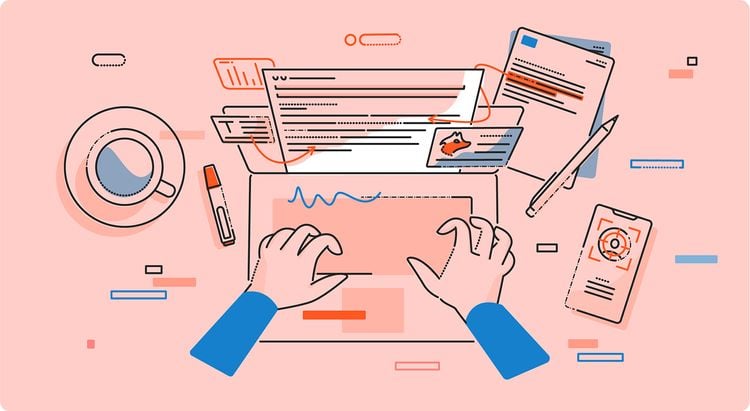
Most people get dozens of new emails in their inbox every day. This makes it hard for any particular email to stand out.
If you want prospects to open your email and engage with it, you need to make sure the copy is on point.
In this blog post, we’re going to share our top email copywriting tips that will help you create high-converting emails every time.
Let’s start.
1. Set a goal
Cold emails must have specific goals. This isn’t only true in the business world—think about your personal emails. Your goal with a personal email might be to catch up with a friend, share an event, or ask a question.
With sales and marketing emails, some common goals include:
- Engaging your target audience
- Promoting a new product or offer
- Pushing prospects to book discovery calls
- Learning more about your target audience and their needs
- Demonstrating how your business is exactly what the recipient needs to alleviate one or more of their existing pain points
Determining what you want to achieve is the first step in the email copywriting process. The goal you identify will guide you through each subsequent step, like determining the most effective subject line and choosing the right opening and closing lines.
2. Keep it short
As you’ll see in the templates we’ve included below, effective emails are emails that stoke intrigue, then follow it up with an immediate offer. Don’t try to explain every detail or tell your whole story—save that for the sales call or your landing page.
To determine what information you need to include in the few lines that make up your email, think about the goal you identified for the email.
In fact, keep that goal in mind through every step of the email copywriting process because, at every juncture, that goal is going to be what determines the decisions you make.
But what if I have a lot to say?
You might find yourself in a situation where you just can’t fit everything you need to say into a short email. So the right course of action is to write a longer email, right?
Not quite. The right course of action in this scenario would be to go back to the drawing board and assess your email’s goal.
If you’re feeling like four or five lines isn’t enough to achieve this goal, the goal you’re aiming for might be too big for one email and more suitable for an email marketing campaign or sequence consisting of multiple emails.
For example, you might be trying to make a sale with cold prospects. That’s huge—and difficult.
Instead, try achieving a smaller goal, like turning cold prospects into warm ones through engagement. Once your target audience is warmed up, making the sale will be a lot easier.
3. Make it clear
This tip can help you keep your emails short. Use only as many words as you need to make your message clear, nothing more.
Sticking to straightforward language isn’t just about keeping your email short, though. It’s also a way to avoid cliches and jargon.
Cliches, like the phrase “just touching base”, don’t really communicate anything. They just take up space and make your email feel generic.
Similarly, industry jargon—the terms only somebody in your industry would know—can confuse recipients.
Stick to words and terms your readers know. This could mean writing at a very basic level if your audience is broad, but it also means you have some room for industry terms if your target audience is more specific, like small business owners or attorneys.
4. Focus on benefits over features
Here’s another way to keep your email focused: promoting your offer’s benefits, rather than its features. This can be tricky, so we’ll break it down in an example:
Features
- Machine learning predicts upcoming expenses based on past months
- A full suite of analytics tools
- Full functionality for team members, customizable functionality settings for contractors
- 24-hour security monitoring
Benefits
- Always get the full financial picture and future forecast
- Get access to data competitors can’t
- Customize exactly which tools contractors can access for their roles, while full-time team members enjoy access to every feature
- Peace of mind that your assets are safe
See the difference? One describes an offer’s features in literal terms, while the other makes promises about what the offer can do for the recipient.
5. Personalize
Personalizing your emails can improve engagement rates significantly. Don’t believe us? Take a look at these statistics:
- Emails with personalized subject lines get 50% higher open rates.
- Adding multiple personalization fields in an email can improve reply rates by 142%.
Fortunately, tools like Hunter Campaigns make it easy to personalize the emails you send.
Email personalization goes beyond including the recipient’s name in the subject line or greeting.
You can personalize an email using the recipient’s name, position, company, hobbies and interests, a milestone they’ve recently reached (e.g., a promotion), or a pain point or challenge they’re dealing with
Research your target audience and focus your personalization efforts on what’s likely to be most important to them.
6. Use storytelling
People connect with stories. People crave stories. Stories make things make sense—your offer included.
Keep in mind, though, that your story needs to fit into the paragraph or so of text in your email. You have two options here:
- Keep the story short (up to three sentences)
- Give recipients a teaser, and then promise they’ll hear the rest of the story when they click through to your website (or book a call with you, or receive the next email in the sequence — the best way to finish the cliffhanger depends on your offer).
If you go with the latter option, you’re using what’s known as the open loop technique. When people start reading a story, they naturally crave its conclusion.
That’s what drives us to binge hours of television shows and stay up way past bedtime with a good book. You can tap into that drive in your email by building intrigue, then promising a satisfying conclusion in your call to action.
Here’s how this might look like:
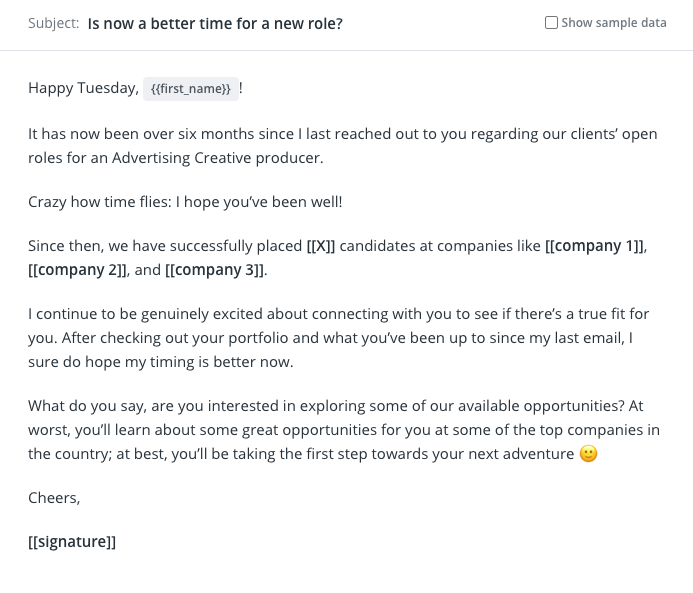
The right story to tell depends on your offer and your brand. For example, you might tell a story about how a personal experience drove you to develop your company or how your product is disrupting its industry.
Go back to your goal and your prospect’s pain points to determine the story that will connect with them and drive them to take the desired action.
7. Create a sense of urgency
What good is a story if it doesn’t inspire urgency in the recipient? Here’s where using actionable language will make the difference between an email that converts and an email that doesn’t convert.
Prospects shouldn’t read your email and say, “that’s interesting;” they should read it and hear their inner voice saying, “buy it!” (or “book the call now!” — you get the idea).
So how do you do that? By using actionable language like:
- Don’t wait
- Don’t miss out
- Find out more
- Get in touch
- Let’s chat
- Learn more
All of these examples are short, direct, and use verbs. Verbs are the core of actionable language because they’re the words that literally describe doing things.
Don’t save them for your call-to-action — use them anywhere they fit into your email.
8. Spend more time on the subject line
Your email’s subject line is the first thing a recipient will notice about your email. It’s got a big job: to snag prospects’ attention and make them open your email.
To craft an effective email subject line, you’ll want to make sure it’s:
Short
Keeping the subject line short will ensure it’s displayed in its entirety even if recipients are opening their inbox on a mobile device. Shorter subject lines are also easier to comprehend. Here are a few examples of effective short subject lines:
- Your feedback, {[first_name}}
- First steps to improving [pain point]
- Have you thought of {{relevant_offer}}?
Personalized
Personalizing the subject line is a great way to grab the recipients’ attention.
There are a number of ways you can personalize the subject line, including mentioning the recipient’s name, company name, industry, pain point, interest or hobby, or a mutual connection.
Here are a few examples:
- Check this out, {{first_name}}
- Fix your [pain point] in [X] weeks
- [Mutual connection] suggested I reach out
Urgent
Instilling a sense of urgency with the subject line will make it more likely that the recipient will engage with your email as soon as possible instead of ignoring it or leaving it for later.
Here are a few examples of subject lines that inspire urgency:
- Are you available [date and time]?
- Resources that can help {{Company Name}} right now
- [Name], will we meet this week?
Valuable
A good way to grab the recipient’s attention is to use the subject line to hint at your email containing something of value to the recipient.
If the prospect doesn’t infer that your email is valuable, they won’t bother opening it.
Here are a few examples:
- Get lifetime access to {{product}}
- Disappointed with [pain point]?
- {{event}} in {{city}}, you’re invited
Arouses curiosity
Even the most valuable-seeming subject line won’t convert prospects if it doesn’t also evoke curiosity. You have to make them wonder, “if I don’t open this email, what am I missing out on?”
Check out these examples:
- Check this out, {{first_name}}
- Open position
- You’re invited
9. Don’t forget the call-to-action
A call-to-action is the line in the closing section of your email that tells the recipient what to do next. Here’s an example:
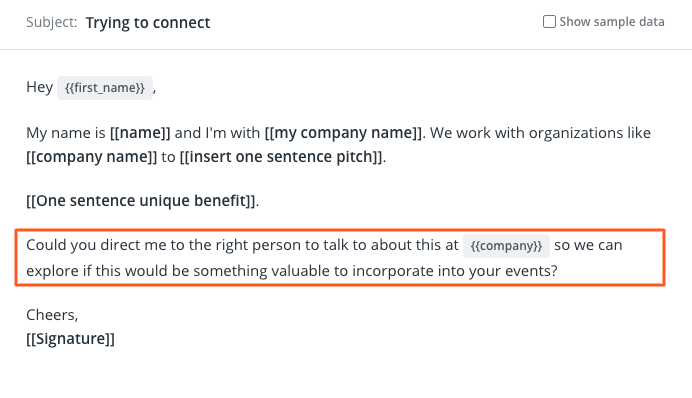
Your email’s call-to-action should tell the recipient to take one specific action. There should be no vague language here—if your goal is for the prospect to book a sales call, your call-to-action should tell them to book a sales call.
If it’s to opt in to a limited-time promotional rate, tell them to opt in now.
Take note of the actionable language in the example above. It doesn’t need to be demanding; it just needs to clearly state exactly what you want the reader to do.
Additionally, make sure not to include more than one call-to-action in the same email. Doing so can only confuse the recipient and make them less likely to take action.
10. Proofread
If your email has grammatical errors, you’re going to lose potential conversions. If recipients see these kinds of mistakes in your email, they’ll wonder what other mistakes you’ll make when working with them.
You can use a tool like Grammarly to proofread your emails and make sure they’re error-free.
When you proofread your email, don’t just look for spelling and grammatical mistakes. Look at the tones present in your writing, too.
Reading your email aloud can help you catch the subtle tones you’ve used, and these can have a big impact on how your email—and, by extension, your offer—is perceived.
11. Take advantage of proven copywriting formulas
Writing a high-converting email doesn’t need to be hard. In fact, there are proven copywriting formulas you can use:
Before–After–Bridge (BAB)
The Before-After-Bridge (BAB) formula is one of the most popular email copywriting techniques because it hits on the prospect’s pain and desire.
It’s a straightforward journey that starts by acknowledging a problem exists, then posits a scenario where that problem doesn’t exist, and finally promises that the scenario can be a reality through the offer.
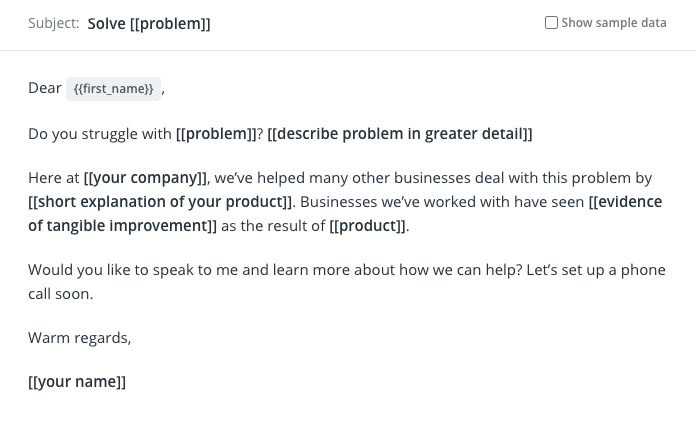
Problem–Agitate–Solve (PAS)
The PAS copywriting formula is somewhat similar to the BAB formula in that it, too, begins by recognizing one of the prospect’s pain points.
But here’s the difference: unlike the BAB formula, the PAS formula follows up this recognition by making the pain feel worse.
Then, in the last act, it provides a solution the prospect can use to find relief from the pain.
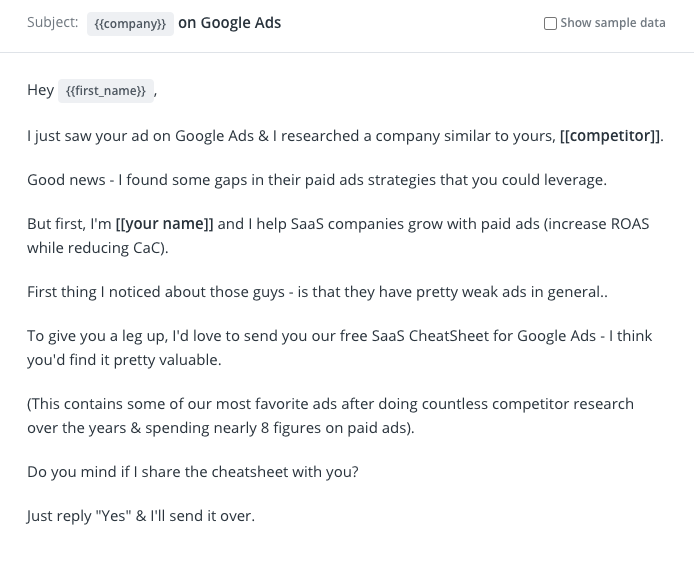
Attention–Interest–Desire–Action (AIDA)
With this formula, you arouse the prospect’s desire for the benefits you’re offering, then drive them to take action. It’s a great choice if your goal is to book a sales call or have the prospect opt into receiving more informational materials about your offer.
The four steps at play in the AIDA formula are:
- Attention – First, you grab the prospect’s attention with emotional, powerful language. Alternatively, you can ask them a question. The goal here is to pique interest.
- Interest – Once you have the prospect’s attention, you need to hold onto it long enough to get them to take action. Emails that use the AIDA formula can run a bit longer than other emails, as you’ll see in the example template below. Offer a solution to the prospect’s pain point or demonstrate that you “speak their language” to hold their attention and build trust.
- Desire – Here’s where you make your offer irresistible. Do this by highlighting its benefits or sharing a story from a previous satisfied customer.
- Action – Finally, close the deal by delivering a concrete call-to-action.
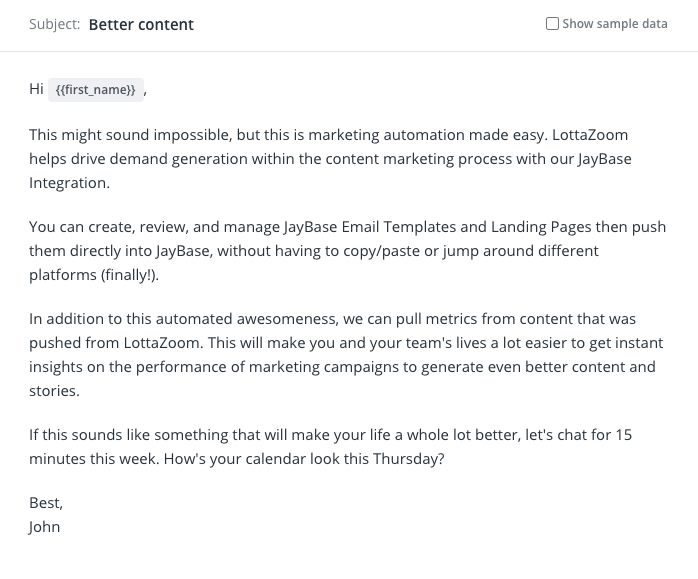
Features–Advantages–Benefits (FAB)
This formula is a great choice if your email’s goal is to generate brand awareness. We know we said your email shouldn’t focus on your offer’s features, and we’re sticking by that.
Despite this formula’s name, it’s really about your offer’s benefits — the features only get mentioned in the context of how they create those benefits.
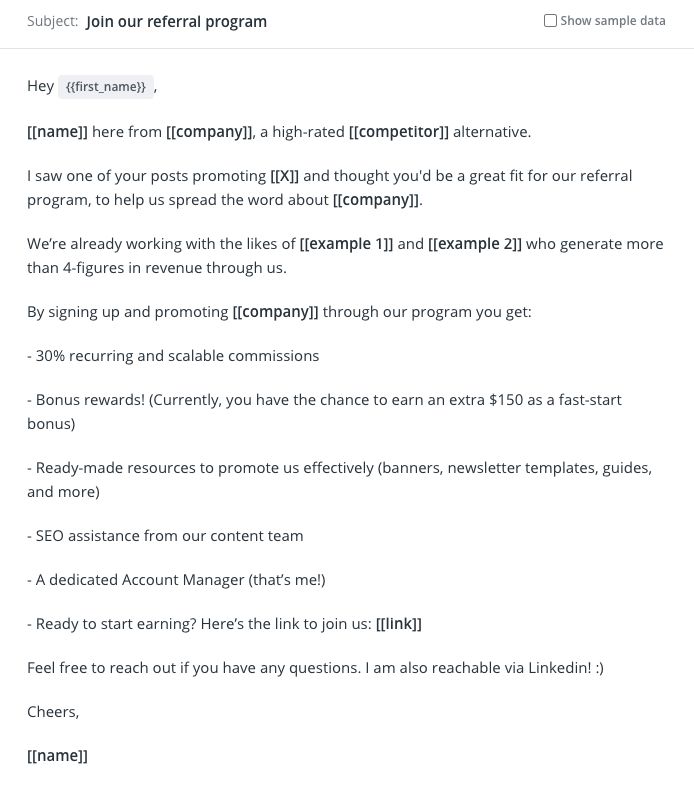
12. Use an email template as a starting point
An email template can be a great starting point for your next email. When using templates, it’s important to adapt them to your needs — avoid using a template word-for-word without adding your own twist to it.
Here are a few of our favorite templates:
Available for a chat?
{{Company} + [[Your company]]
Quick win for {{company}}
Ready to discuss [[problem]]?
See how these templates are all unique, but they all include the same core components like mentioning the prospect’s pain point, offering a solution, and a clear call to action?
Remember these non-negotiable points next time you write a sales email. If you get stuck, refer back to our templates library and take a look at a few templates for emails similar to yours.
Start writing high-converting emails
As you can see, a lot goes into writing an effective email. However, if you follow the tips we outlined, you’ll definitely be able to draft a high-converting email.
If you need more help with creating profitable email campaigns, check out these posts:
- The Complete Guide to Getting Started with Cold Email
- The Best Time to Send an Email (What 9 Studies Say)
- How to Write a Follow-Up Email After No Response (7 Examples)
- 11 Ways to Find Someone's Email Address in 2022 (Detailed Guide)

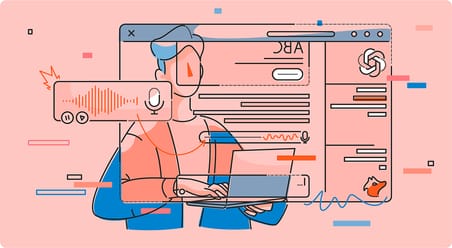


 Send cold emails with Hunter
Send cold emails with Hunter